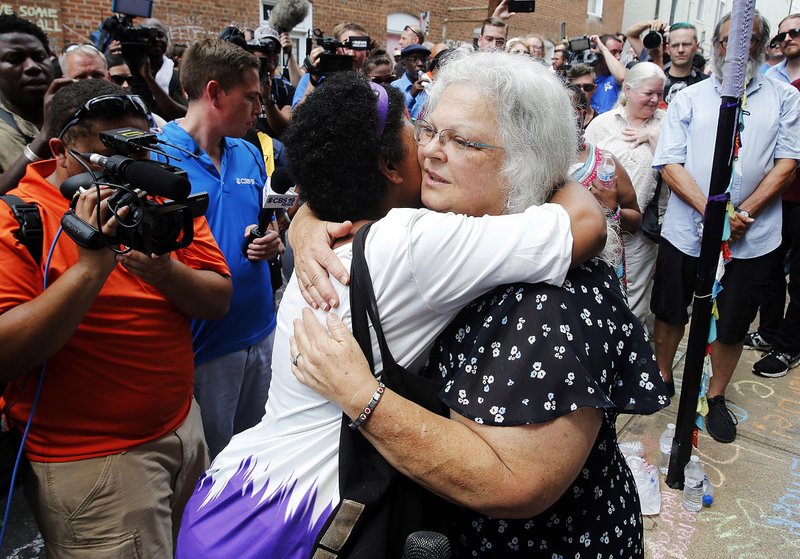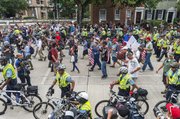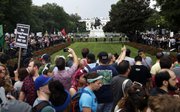WASHINGTON -- A year after the race-fueled violence in Charlottesville, Va., hundreds of demonstrators gathered Sunday in the city, and thousands more rallied near the White House, to denounce racism and hate groups.
In Virginia, the mother of Heather Heyer, the woman killed at last summer's protest, said the country continues to face unhealed racial wounds.
The counterprotest in Washington was sparked by a march by about two dozen white supremacists organized by the Unite the Right group, which planned for 100 to 400 people, according to the permit it received from the National Park Service. The white supremacists stayed in Lafayette Square, a park just north of the White House, for a short time and left before 6 p.m. Sunday. They had been scheduled to hold a two-hour rally in the square beginning at 5:30.
The group's organizer, Jason Kessler, and his supporters were escorted by police in riot gear from the moment they arrived in Washington. Kessler earlier Sunday denounced the idea that he was a white supremacist, saying he was promoting free speech and fighting abuses of "white people's civil rights."
"I am not a white nationalist. I'm a civil-rights advocate," he said. "I'm focusing on white people because we don't have civil-rights advocates."
At Lafayette Square, Kessler stood on a platform with a microphone, addressing attendees who arrived before the event was scheduled to begin. He blamed a harsh law enforcement response after last year's Charlottesville rally for his group's meager showing.
"There were a lot of people who were at last year's rally who are very scared this year," he said. "They felt like last year they came to express their point of view. They were attacked. And when they fought back, they were overly prosecuted."
On Aug. 12, 2017, hundreds of neo-Nazis, skinheads and Ku Klux Klan members and other white nationalists descended on Charlottesville, in part to protest the city's decision to remove a monument to Confederate Gen. Robert E. Lee from a park. The statue is still standing; a 1904 Virginia state law makes it illegal for cities or counties to remove war memorials on their own. Activists who want to keep the statue filed suit last year, and a judge has not yet issued a ruling.
Counterprotesters on Sunday who had been shouting "Go home, Nazis, go home!" started booing when the white nationalists did just that. A new song then broke out: "Na na na na, na na na na! Hey, hey, hey, goodbye!"
Many in the crowd of counterprotesters wore the signature black masks, helmets and body armor of the anti-fascist movement, popularly called Antifa, which clashed violently with white supremacists in Charlottesville.
The white nationalists later packed into white vans and left, escorted by the police.
With Kessler's group gone, the mood among the counterprotesters grew mildly celebratory, although rain led many to leave. One chanted, "I believe that we just won."
Counterprotester Mike Isaacson said the group had planned to march to the headquarters of U.S. Immigrations and Customs Enforcement, but police rerouted them to the Department of Justice. He said they had not planned to have a confrontation with police. "We were just taking the streets," he said.
But some of them did confront police who had kept them separated from the white nationalist demonstrators. After Kessler's group left, black-clad counterprotesters launched flares and fireworks toward the White House compound. Roughly 200 of them then moved east, turning over trash bins and chanting anti-police slogans.
The counterprotesters later tried to push past a line of officers on motorcycles engaged in crowd control. Some officers scuffled with the activists and used mace in response.
Washington Police Chief Peter Newsham said only one person was arrested all day.
He said officers' work Sunday was part of "a well-executed plan to safeguard people and property while allowing citizens to express their First Amendment rights."
President Donald Trump wasn't in the White House on Sunday. He has been at his golf club in New Jersey for more than a week on a working vacation.
MOURNING HEYER
In Charlottesville on Sunday, Heyer's mother, Susan Bro, laid flowers at a makeshift memorial at the site of the attack in downtown Charlottesville.
"I dreaded today," she said. "I felt the heaviest weight in my heart last night. I got here, and all the sirens were freaking me out. And then a calm settled over me."
With a crowd gathered around her -- many wanting to hug her -- she thanked people for coming to remember her daughter, but she also acknowledged the dozens of others injured and the two state troopers killed that day, Lt. Jay Cullen and Trooper-Pilot Berke Bates, when their helicopter crashed.
"There's so much healing to do," Bro said. "We have a huge racial problem in our city and in our country. We have got to fix this or we'll be right back here in no time."
On Sunday, the city of Charlottesville said four people were arrested, and there were scattered skirmishes throughout the day. Two arrests stemmed from a confrontation near Lee's statue where a Spotsylvania, Va., man stopped to salute it. A Charlottesville woman confronted him, and a physical altercation took place, officials said.
Dozens of police officers congregated near the Lee statue, which was buttressed by numerous barriers. Authorities would allow only 50 people near the statue at a time.
Earlier in the day in Charlottesville, more than 200 people gathered in a park to protest racism and mark the anniversary. The group sang songs and listened to speakers, among them Courtney Commander, a friend of Heyer's who was with her when she was killed.
"She is with me today, too," Commander said.
Protesters in Virginia needed to enter the fortified downtown pedestrian mall, where authorities banned anything that could be fashioned into a weapon or projectile, including glass bottles. Some protesters did not come inside, saying they didn't feel comfortable going through the police checkpoint, but most ultimately did.
Much of the anger, onlookers and protesters said, centered on the contrast between last year, when police were harshly criticized for not responding forcefully enough during the white supremacist rally, and this year, when they've been everywhere.
"I was here last year, and was almost hit by the car," said resident Zoe Spellman, 31. "It's sad that our relationship with the police is manifesting itself this way. I saw last year how they would not help us. We begged for help on the 11th [of August]. We begged for help on the 12th. ... And for we white people, this was the first time we felt what black people must feel all the time."
Police said they were aware of the consternation that their strong presence has elicited among some protesters, but they said it was necessary.
"We are trying to maintain order and have a duty and obligation to try and make sure there is no property damage," said Charlottesville police spokesman Tony Newberry. "We're here to protect the different groups who have come here to voice their First Amendment rights."
Information for this article was contributed by Noah Weiland and Andy Parsons of The New York Times; by Michael Kunzelman, Sarah Rankin and Ashraf Khalil of The Associated Press; and by Terrence McCoy, Joe Heim, Reis Thebault, Peter Jamison, Marissa Lang, Hannah Natanson, Teo Armus, Martine Powers, Michael Brice-Sadler, Peter Hermann, Perry Stein, Fenit Nirappil and Antonio Olivo of The Washington Post.
A Section on 08/13/2018



